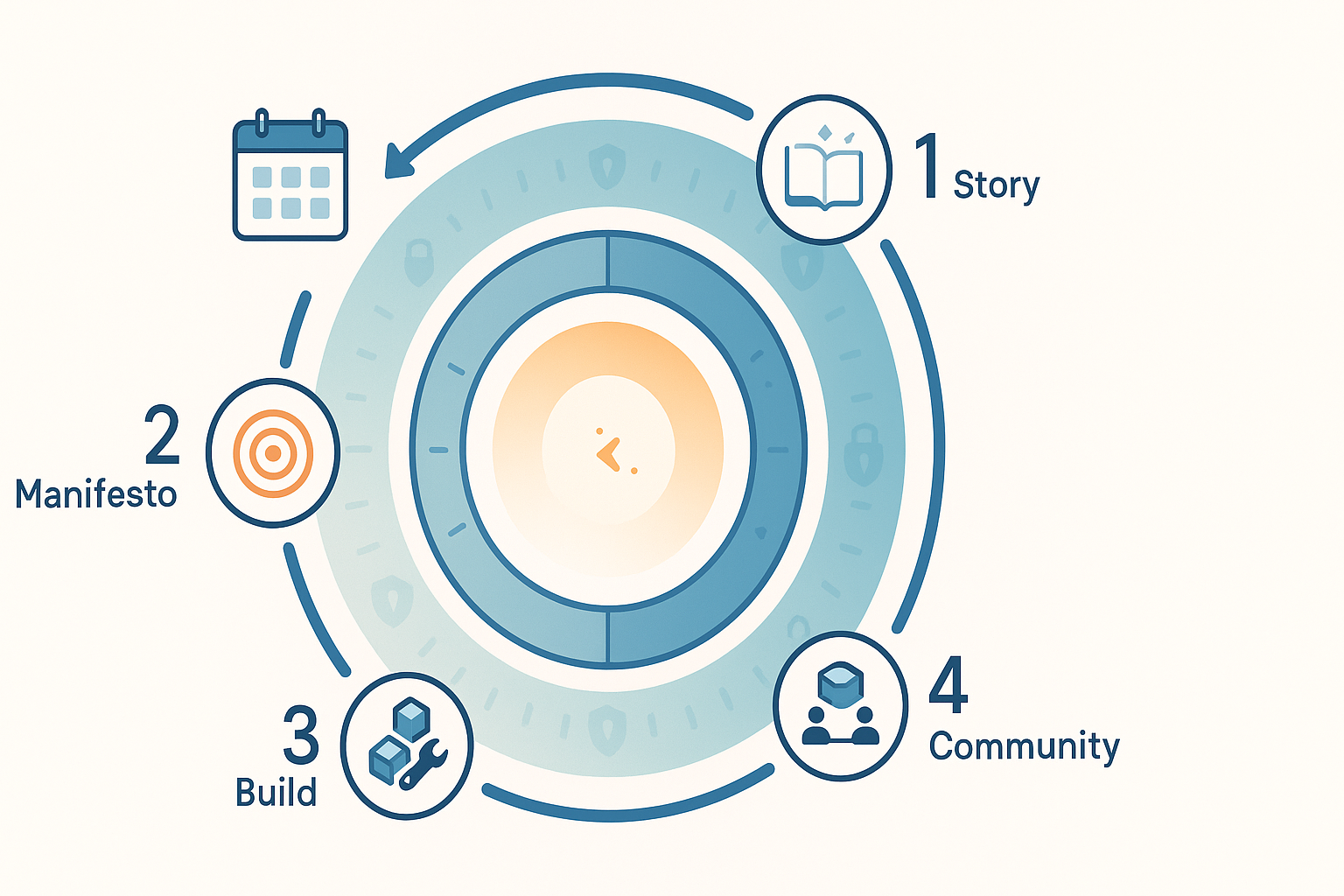The Three Layers of a Regular Hackathon Practice
A regular hackathon schedule gives you three deeper benefits that compound over time: Ideation, Ritual, and Cognitive security.

Ideation → Ritual → Cognitive Security, and why the four steps (Story → Manifesto → Build → Community) must stay in that order
Most people think hackathons are about speed. They are—but speed is only the surface benefit. A regular hackathon schedule gives you three deeper benefits that compound over time:
- Ideation: it reliably converts fuzzy ideas into testable shapes.
- Ritual: it creates a repeatable cadence that compounds skill and learning.
- Cognitive security: it protects your attention from drift, distraction, and external agenda-setting.
Below, I’ll unpack each layer, then show why the four-step sequence—Story → Manifesto → Build → Community—must be followed in that order to make the practice effective. We’ll close with multiple time-scale formats (from 1 hour to 4 weeks) and a “start tomorrow” checklist.
Layer 1: Ideation (make the invisible visible)
A recurring hackathon turns idea space (free to think, cheap to change) into artifact space (visible, discussable, falsifiable). You’re not forcing “the best idea”—you’re creating a regular conduit where ideas can safely appear, be shaped, and be tested.
What improves:
- Problem framing: you learn to state the problem in smaller, testable chunks.
- Optionality: you build an idea bank without committing identity to any single idea.
- Signal-to-noise: regularity replaces inspiration scarcity; you stop overvaluing rare bursts of motivation.
Layer 2: Ritual (process that compounds)
Ritual is the core. Done regularly, it compounds the invisible assets: taste, pattern recognition, skill stacking, reputation, and relationships. The output of one cycle seeds the next. The practice becomes your operating system.
What improves:
- Consistency without burnout: time-boxed cycles let the work flex, not the schedule.
- Feedback quality: the ritual makes feedback predictable—people know when and how to engage.
- Teamability: the cadence is legible to collaborators; it lowers coordination costs.
Layer 3: Cognitive Security (attention you can trust)
The modern attention economy is adversarial: every feed wants to hijack your agenda. A recurring hackathon is a self-defense protocol for your cognition. Time-boxing, reflection, and order of operations keep you from:
- Shiny-object chasing: you park new ideas in the next cycle instead of derailing this one.
- Prompt dependence: tools assist your plan instead of dictating your next step.
- Scope creep & identity traps: you explore deeply without marrying your identity to any single project.
The Four Steps (and why the order matters)
A hackathon cycle has four pieces. The sequence is the safety rail. Change the order and you’ll recreate the very failure modes the practice is designed to prevent.
1) Story (Where am I, really?)
Short reflection that captures your current state, constraints, values, and resources.
- Outcome: grounded starting point; you avoid building on false assumptions.
- If skipped: you optimize for the wrong world; future “wins” pull you off course.
Prompts:
- What changed in the last cycle? What hurt/helped?
- Which values must this cycle protect?
- What resources (time, energy, access) are actually available?
2) Manifesto (Where am I going, and with whom?)
Choose a direction, a user, and a promise. It’s targeting, not tunnel vision.
- Outcome: a crisp definition of success for this cycle.
- If skipped: you create tech demos that impress no one and help no one.
Template:
- For [specific person/group]
- who struggle with [specific pain],
- we will deliver [specific outcome]
- in [time-box], validated by [observable signal].
3) Build (One contained push)
Produce the smallest artifact that can start real conversations. Done is better than bigger.
- Outcome: a tangible thing that can be used, critiqued, or extended.
- If done before Manifesto: you’ll build “something cool” that doesn’t connect.
Rules:
- Time-box strictly.
- Defer anything not required by the manifesto.
- Keep a “parking lot” for ideas that arrive mid-build.
4) Community (Turn output into conversation)
Share with a handful of real people (aim for 10). Ask for specific feedback aligned to the manifesto.
- Outcome: validation, refinement, and relationships; your next cycle’s inputs.
- If skipped or swapped earlier: you’ll chase dashboards and “marketing” instead of insight and trust.
Prompts:
- What did you try? What worked? What broke?
- If you had one request for me before the next cycle, what would it be?
- Who else should see this?
Why the order guarantees effectiveness
- Story → Manifesto ensures alignment before action.
- Manifesto → Build ensures focus during action.
- Build → Community ensures learning after action.
- The next cycle’s Story ingests the learning to avoid repeating mistakes.
This pipeline turns effort into compounding knowledge rather than isolated activity.
The cadence: time-box the cycle, not the work
Think Agile for humans: you define the time window, then adapt scope to fit. That’s how you stay sustainable.
Standard 4-week rhythm
- Week 1 — Story (reflection & inventory)
- Week 2 — Manifesto (target and success criteria)
- Week 3 — Build (ship the smallest useful artifact)
- Week 4 — Community (share, collect feedback, recruit collaborators)
Compressed formats (same order, smaller slices)
- 1-Hour hackathon:
- 15m Story → 15m Manifesto → 20m Build → 10m Community share
- 1-Day sprint:
- Morning Story+Manifesto; afternoon Build; end-of-day Community demo
- 1-Week sprint:
- Mon: Story; Tue: Manifesto; Wed–Thu: Build; Fri: Community
Pick the scale that fits your life. The value comes from repeating the cycle, not stretching it.
Failure modes the sequence prevents
- Starting with Build: exciting output, weak purpose → low adoption.
- Community before Build: performative “launches” with nothing to engage.
- Manifesto without Story: precise goals built on outdated or imaginary constraints.
- Skipping Community: momentum dies; no trust, no feedback, no compounding.
Simple metrics that keep you honest
- Agenda control: % of tasks that trace back to the Manifesto.
- Time on task vs. context switches: fewer switches = better cognitive security.
- Trust delta: number of people who opted into deeper collaboration this cycle.
- Validation cost: time you spent verifying your own/agents’ outputs; should trend down.
- Carryover rate: how much work spills over; watch for chronic over-scoping.
Tooling that helps (optional but useful)
- Story worksheet: one page, same prompts every cycle (makes trends visible).
- Manifesto card: small, frictionless, shareable.
- Parking lot: a simple list; prevents mid-cycle derailment.
- Community roster: 10 real humans you’ll ship to every time.
- Kill switch: pre-agree conditions to stop/ship/re-scope mid-cycle without drama.
Start tomorrow: a 60-minute mini-hackathon
- Story (15m): What’s true right now? What must this cycle protect?
- Manifesto (15m): Who’s it for? What outcome in 30–60 minutes counts as success?
- Build (20m): Produce the smallest artifact that earns a reaction.
- Community (10m): Share it with 2–3 people. Ask one question: “What would you change first?”
Schedule your next cycle before you close the tab.
Bottom line
A recurring hackathon is not a special event; it’s a personal operating system.
- Ideation keeps you prolific and adaptable.
- Ritual keeps you consistent and compounding.
- Cognitive security keeps you sovereign over your attention.
Follow the order—Story → Manifesto → Build → Community—and let the time box set the pace. The work will expand or contract to fit, and over time, the person doing the work will change too. That’s the real point.
Need Help Getting Started?
You don’t need more theory. You need a date on the calendar.
If you’d like me to coach you through a 4-week personal hackathon, take the quick assessment and see if we’re a fit: https://hack.leoasaservice.com/
